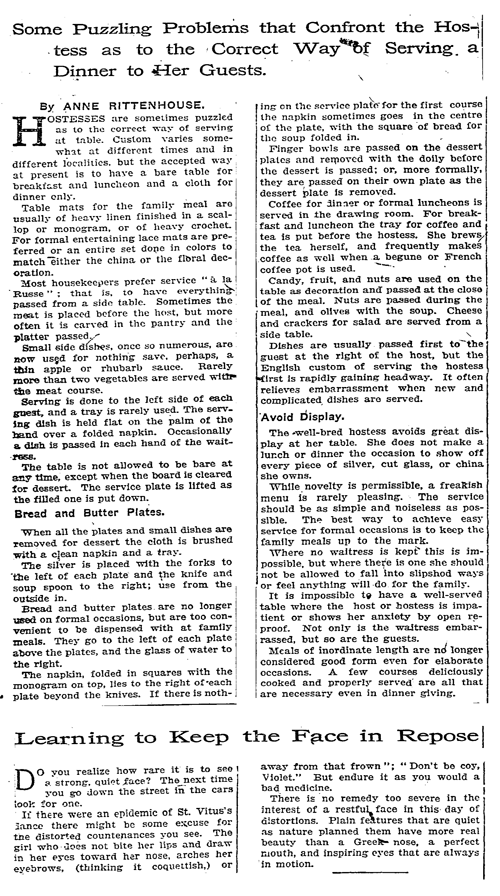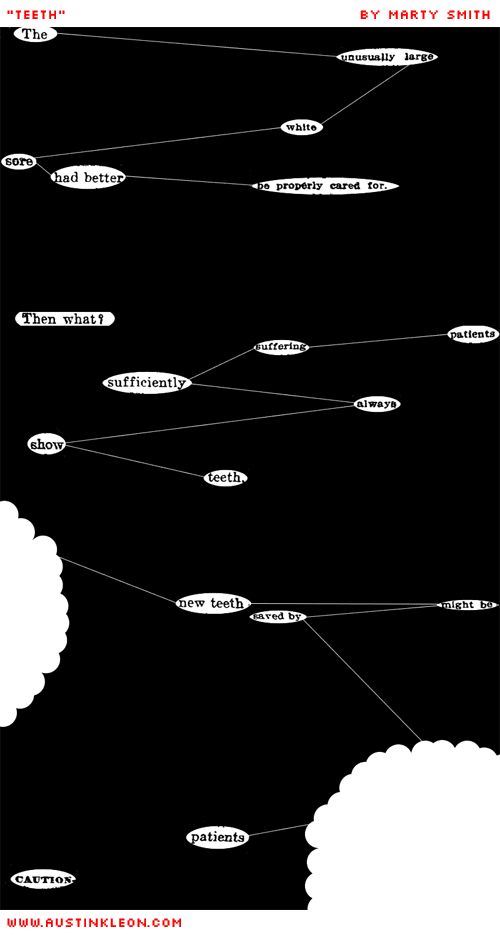Yes, we did.
NOVEMBER NEWSPAPER BLACKOUT POEMS CONTEST
The contest is now closed. See the winners!
Read the official contest rules.
For this contest, one winner and three runners-up will receive a free copy of the book, along with the chance to be published in the book!
To enter the contest, you must be 18 and a US resident (sorry to all you young’uns and overseas folk!) One entry per monthly contest.
The two columns of newspaper below are from November 1, 1908, 100 years ago. Your challenge, should you choose to accept it, is to turn them into a poem.

[download high-quality GIF image] | [download PDF]
Directions
You can go about the creation of your poem in one of two ways:
WITH MARKER FUMES
- Download the PDF and print it out (you will need Adobe Acrobat Reader)
- Black out the words in the newspaper text into a poem
- Scan or take a digital picture of the poem. Be sure it’s readable.
- Save an image of the poem as a .jpg, .gif, or .png file less than 2MB in file size
- Send in the file along with the required information using the submission form
WITHOUT MARKER FUMES
- Download the high-resolution GIF and save it to your desktop (right-click save as on the link)
- Open the GIF with an image-editing program like Paint or Photoshop
- Black out the words in the newspaper text into a poem
- Save an image of the poem as a .jpg, .gif, or .png file less than 2MB in file size
- Send in the image file along with the required information using the submission form
TIPS
- Combine both columns into one poem—don’t just do each column at a time! It doesn’t make for a good read. Skip between the two…this allows for more interesting possibilities. You can see the previous winners here and here and here.
- Remember that Westerners read left-to-right, up-to-down. Poems read best if they follow that pattern.
- You can get around the left/right/up/down problem by connecting words with whitespace. (See an example.)
- What you are doing when making a blackout poem, in the words of Allen Ginsberg, is “shopping for images.” Nouns and verbs make the best images.
- Regardless of where it’s located in the text, I always start a poem by looking for a word or image that resonates with me and move from there.
- It’s a lot like a word search.
- You don’t have to use the whole text. What to leave in / leave out / how long is the magic.
- Poetry doesn’t have to be serious!
- Try not to think to hard about it and let it flow! It might take you a bunch of tries. Don’t be intimidated! Anyone can do it!
One winner and three runners-up will be announced at the end of the month.
See the previous winners from August, September, and October.
Help us spread the word! Link to:
http://www.austinkleon.com/newspaper-blackout-poems
Good luck!
Submission form
Read the official contest rules.
Remember: only US residents 18 and older. One contest entry per month, please. Be sure to fill out all required fields and keep your image file limited to 2MB or smaller.
All entries must be submitted by November 21, 2008 (5:00 P.M. EST)
The contest is now closed. See the winners!
Problems with your submission? E-mail: blackoutpoems [at] gmail [dot] com
THE NEW HOUSE
In the midst of the mortgage crisis, Meg and I went out and bought a house. We closed today, we move in this weekend. In the five years that we’ve known each other, we’ve never lived in anything bigger than a one-bedroom apartment. Now we both have offices, a washer/dryer, a two-car garage…it’s very surreal.
When you live with someone in a tiny apartment, you’re always in close proximity. You never see that person more than 10 or 20 feet away, because there isn’t 10 or 20 feet to gain between you. You get used to seeing them from a particular distance.
Meg and I often meet each other for lunch on campus. When I see her from far away, walking towards me, she looks like a different person—she looks like a stranger, or someone I just met. It’s like a visual refresh. (I wonder if this visual element isn’t part of the hidden magic of what self-help couples books tell you to do: meet for dinner, but take separate cars…)
I’m reminded of this passage from Dylan Horrocks’ Hicksville:
Maps are of two kinds. Some seek to represent the location of things in space. That is the first kind – the geography of space. But others represent the location of things in time – or perhaps their progression through time. These maps tell stories, which is to say they are the geography of time. […] But these days I have begun to feel that stories, too, are basically concerned with spatial relationships. The proximity of bodies.
I wonder about this proximity of bodies. I wonder how we will grow in a bigger space, with an upstairs and downstairs. How our changing spatial relationships might alter our story…
Above is a sketch of the house, superimposed over a page from William Maxwell’s wonderful short novel, So Long, See You Tomorrow.
TV ON THE RADIO @ STUBBS
Sharpie marker on index cards, drawn at a TV On The Radio concert tonight at Stubb’s.
If you don’t know TV On The Radio, you’re missing out. Buy their new album.
I find myself getting really fidgety at concerts lately, which is why I bring something to draw with. I don’t understand, in this modern age, why there’s so much downtime in between sets. What the hell is a sound check for, if you can’t have instruments tuned up and ready to go? Can’t we get some stupid stand-up comic out on stage to tell some jokes? Can’t we get a video screen with some 30 Rock or something? Dang.
What ticks you off about rock concerts? What do you love about rock concerts? What was the last great rock concert you saw?
WINNERS OF THE OCTOBER NEWSPAPER BLACKOUT POEM CONTEST
Lots of dentistry-themed poems this month, but the winner was Marty Smith of Washington, DC, for his poem, “Teeth.”

I dig the graphic inventiveness of Marty’s poem—”subtraction” method, indeed!
Our runner-ups were all from the grand state of Illinois: Pete Anderson from Joliet, and Kristen Delap and James Francis Flynn from Chicago.
Congratulations, Marty, Pete, Kristen, and James! Y’all will get your free books next September.
Okay, folks: you have one more shot at a free book. Check back November 1st for the next contest!
- ← Newer posts
- 1
- …
- 480
- 481
- 482
- 483
- 484
- …
- 635
- Older posts→










